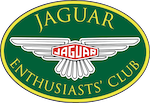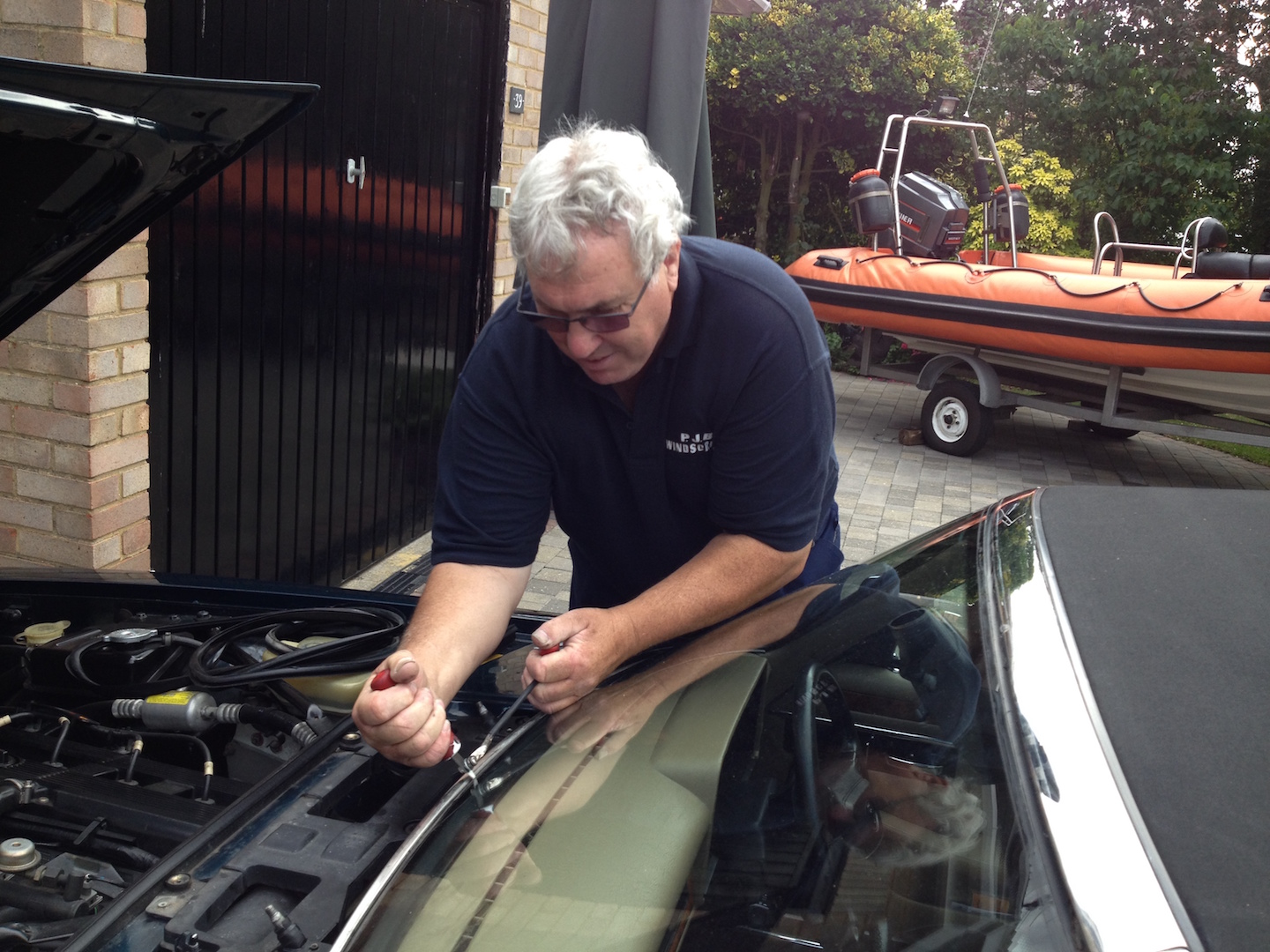Like many an old car, when you are thinking of buying an XJS, you need to consider its inherent faults….and there are a few. If you ignore the misguided comparisons that were made at the time with the much-loved, though long in the tooth, E Type that it superseded – but which, crucially, it did not replace – you are left with largely quality issues that could be summed up in two words: British Leyland! Component failures, build quality that would give some Eastern Bloc countries a run for their money, paint issues (did you know they would paint damp body shells?) and rust all conspired to almost guarantee unreliability. That and a voracious thirst for petrol at the height of the fuel crisis finally sealed its reputation resulting in sales barely scraping into the thousands per year.
Yet despite all this, and against some boardroom resistance, it survived. And it got better as the years passed. Michael May’s split level combustion chamber (1981) which sorted its thirst – well, sort of – was the key change. A steady progression of modifications and upgrades followed and kept the sales going until Ford’s acquisition of Jaguar in 1989, whereupon the build quality issues were finally addressed. It was still some time before I warmed to it, however. Being based on the then XJ6 floor pan and mechanicals, I knew that this part was well proven and Malcolm Sayer’s low slung lines with, some say, slabby sides and that billiard table bonnet and long rear overhang did, in my mind, gift it with all the right proportions to be an attractive car. But it wasn’t until the final facelift around 1993 which gave it, most noticeably, colour-keyed plastic bumpers, that I thought this could really be the car for me; and the convertible 2 + 2 was the best looking of the lot. Yes, with Ford’s £50 million investment and the late Geoff Lawson’s plastic surgery, I had to have one! I have since found that it does live up to its original brief, being a smooth, effortless, long-distance cruiser. So, what could go wrong with a ’94 4.0 litre convertible in very good condition with 52K on the clock? Well, something that 20 years of development seems to have passed over.
I do remember reading about it in the Club Mag a couple of years ago, so I was aware of this when viewing my prospective purchase and indeed there were signs that a repair had been done in the past – so I bought with confidence. But back to the present and, just before our Deauville trip, a small crack appeared in the offside corner of the windscreen, ominously with no obvious stone chips visible. I feared the worst. Throughout that weekend, the crack worked its way north up the screen, even splitting into several tributaries on its meandering course to the headrail. Not really a problem in sunny Deauville, but we drove through torrential rain most of the way home. No issues with the sorely tested hood, but water ingress from below the dash is simply not allowed. Something had to be done, and fast!
Following a call to my insurers, Footman James dispatched an Autoglass fitter. However, he did admit to little experience with such cars and, whilst the company did offer to put their top instructor on it at their headquarters, I was still not warmed by a rosy glow of confidence; so I politely declined their services. This left me with no one to fit the screen. So, at times like this, who should I call? JD Classics, of course. They advised that, whilst they did not undertake such works on a bonded screen themselves, they did employ a company that did. An appointment was then duly confirmed with P.J.B. Windscreens of Chelmsford; how handy is that? They arrived at the appointed hour with a brand new windscreen and, more importantly, plenty of expert knowledge.
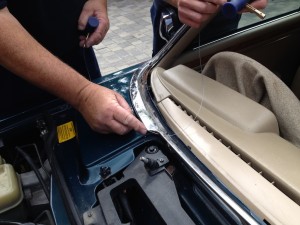 Now, there are several pieces of bright work around the screen with the lower section stuck to the scuttle by silicone. Needless to say, this piece has to be removed and it can easily bend, leaving a permanent crease mark. Onto the internet then to obtain spares, just in case. I did manage to obtain a side flashing and the head rail finisher, but that bottom rail…..it would have been easier to order a set of false teeth for a bald eagle! But I shouldn’t have worried; the chaps from P.J.B simply used a cheese cutting wire to slice through the silicone as if it were a wedge of Saint Paulin. Once the screen was removed, the cause of the cracking was laid bare, the metal lipping of the panel had expanded with rust and applied pressure to the inner glass face, eventually causing it to crack. At least I had expected this outcome, so the surprise factor was low.
Now, there are several pieces of bright work around the screen with the lower section stuck to the scuttle by silicone. Needless to say, this piece has to be removed and it can easily bend, leaving a permanent crease mark. Onto the internet then to obtain spares, just in case. I did manage to obtain a side flashing and the head rail finisher, but that bottom rail…..it would have been easier to order a set of false teeth for a bald eagle! But I shouldn’t have worried; the chaps from P.J.B simply used a cheese cutting wire to slice through the silicone as if it were a wedge of Saint Paulin. Once the screen was removed, the cause of the cracking was laid bare, the metal lipping of the panel had expanded with rust and applied pressure to the inner glass face, eventually causing it to crack. At least I had expected this outcome, so the surprise factor was low.
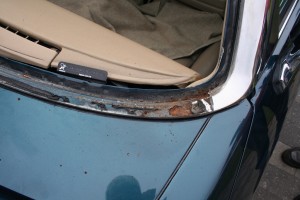 Apparently, water collects under the bright work screen surround and the metal lipping of the bulkhead and stays there. This is exacerbated on the Coupe models when the drainage tubes from the roof become blocked, although there don’t appear to be any on the Convertible. Over time, the water gets past the protective paint and rots the steel. I’ll blame poor design and possibly inadequately bonded glass. More of a time- and quality-related issue than high mileage. In any event, there was no way the screen could be immediately replaced with this level of corrosion damage present. Unfortunately, the other side was also showing signs of similar deterioration. P.J.B. kindly offered to return and complete the job once I had addressed the much-needed repairs. So, time to break out the angle grinder, wire brushes and rust killer.
Apparently, water collects under the bright work screen surround and the metal lipping of the bulkhead and stays there. This is exacerbated on the Coupe models when the drainage tubes from the roof become blocked, although there don’t appear to be any on the Convertible. Over time, the water gets past the protective paint and rots the steel. I’ll blame poor design and possibly inadequately bonded glass. More of a time- and quality-related issue than high mileage. In any event, there was no way the screen could be immediately replaced with this level of corrosion damage present. Unfortunately, the other side was also showing signs of similar deterioration. P.J.B. kindly offered to return and complete the job once I had addressed the much-needed repairs. So, time to break out the angle grinder, wire brushes and rust killer.
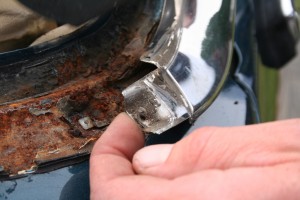 Luckily the brown steel cancer had not spread far enough to warrant the amputation of large areas of bodywork; this was a relief, since most parts are obsolete and hence difficult to source. Two-pack filler and aluminium gauze proved sufficient to remedy the small holes left by that thankfully departed brown oxide. Given more time, I would have favoured lead loading, but the clock was ticking. In fact the paint was still drying when I called P.J.B. who returned within the hour. It was now around 4.00 pm and the team of two set about installing the new screen with gusto.
Luckily the brown steel cancer had not spread far enough to warrant the amputation of large areas of bodywork; this was a relief, since most parts are obsolete and hence difficult to source. Two-pack filler and aluminium gauze proved sufficient to remedy the small holes left by that thankfully departed brown oxide. Given more time, I would have favoured lead loading, but the clock was ticking. In fact the paint was still drying when I called P.J.B. who returned within the hour. It was now around 4.00 pm and the team of two set about installing the new screen with gusto.
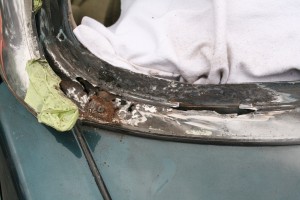 Having cleaned all the surfaces and fixed the necessary rubber surround they carefully bonded the screen to the car, screwed back the side finishers and refitted the lower stainless steel trim, mercifully undamaged, to the scuttle. The plastic channels that this sits in are also obsolete, but SNG Barrett do a rubberised version. Unfortunately, these only arrived after we had finished so the original items were re-used, hence I cannot comment on their suitability. The chaps from P.J.B., one of whom was the proprietor, did a splendid job – not one scratch or bent piece of trim. All this was achieved in one day in July, working against the clock from 9.00am to 4.30pm. Thankfully, it was sunny. Well, it did rain a little, but the patio sun shade made a good umbrella.
Having cleaned all the surfaces and fixed the necessary rubber surround they carefully bonded the screen to the car, screwed back the side finishers and refitted the lower stainless steel trim, mercifully undamaged, to the scuttle. The plastic channels that this sits in are also obsolete, but SNG Barrett do a rubberised version. Unfortunately, these only arrived after we had finished so the original items were re-used, hence I cannot comment on their suitability. The chaps from P.J.B., one of whom was the proprietor, did a splendid job – not one scratch or bent piece of trim. All this was achieved in one day in July, working against the clock from 9.00am to 4.30pm. Thankfully, it was sunny. Well, it did rain a little, but the patio sun shade made a good umbrella.
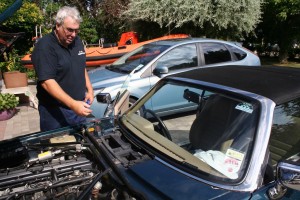 This is a well-known XJS weak spot so, when you see some minor paint bubbling at the bottom corners of the windscreen surround, beware. The rest of the iceberg lurks beneath.
This is a well-known XJS weak spot so, when you see some minor paint bubbling at the bottom corners of the windscreen surround, beware. The rest of the iceberg lurks beneath.
Neil Shanley
Footnote: At the NEC Show in November, I saw that SNG Barrett had an almost identical XJS on their stand, which was really good news and a sign that the cars are gaining in popularity. I talked about the spares situation with them and, whilst they do a reasonable range of mainly consumables, certain body trim items, including door hinges and bright work, are not yet available. Back to the breakers yards then. My thanks go, as ever, to Bob King for his invaluable help in completing the repairs.
